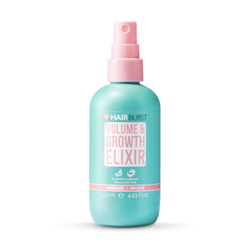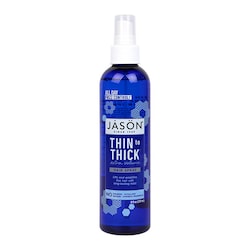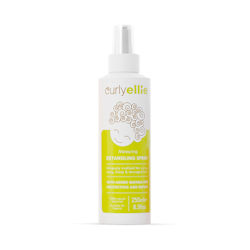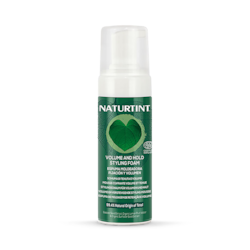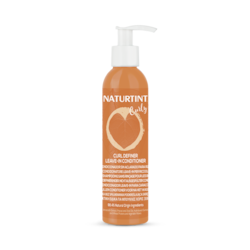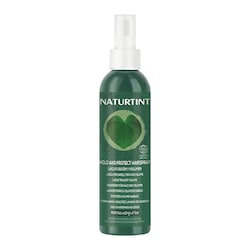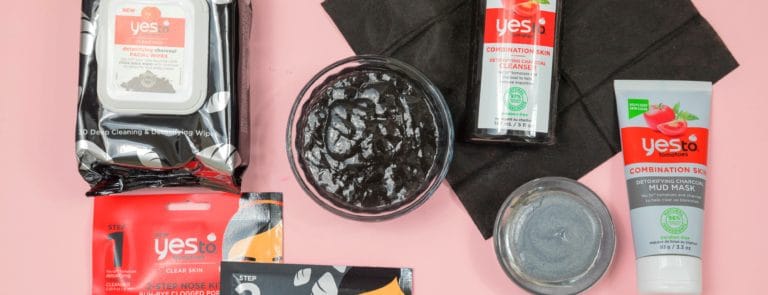15% off £30 OR 20% off £40
How to get wavy hair without heat
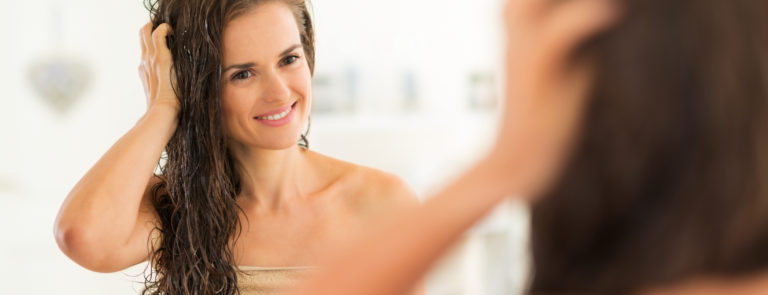
Have you been struggling to come up with ideas how to make wavy hair a reality without reaching for the curling irons? You’re not alone.
Lots of us are choosing to move away from excess heat and the hair damage that often comes with it.
Instead, we’re looking for more natural and hair-friendly ways to get those waves flowing!
Here are 9 ways how to get wavy hair without heat.
Why is heat bad for our hair?
Whenever we go to the hairdressers, you may have noticed that they never use heat on our hair without using a heat protector first.
But why is that? Essentially, using too much heat can damage your hair – and here’s why.
Hairstylist Stacy Ciceron highlights that heat is bad for our hair because it can damage the texture of our hair.
In particular though, heat can have a negative impact on curly or wavy hair types as it might make you permanently lose your curl pattern.
If you have straight hair, too much heat can make your hair look dry and brittle – as well as highlighting any split ends you may have.1
Handpicked content: Dry hair - causes & treatments
Why are curlers bad for our hair?
Curlers and rollers can potentially damage our hair.
With rollers, if wound too tightly this may cause hair breakage along the shaft.
When worn too often or overnight, the tension can damage your roots which may then lead to hair loss.
With curlers and heated rollers, excess exposure to high temperatures can dry out the hair leaving it looking frazzled and damaged.
Can you get curly hair with no heat?
Fortunately, there are a whole host of ways you can get curly hair without heat.
Whether you use a tool or just your fingers, we’ve listed several ways you can create no heat curls, below.
How to curl your hair without heat
There are plenty of methods you can use to create natural waves in your hair.
Whether it's through a new hairstyle, or swapping some of your usual hair products, we've got 10 ways to get wavy hair for you to explore.
1. Braids
Braids are cute. And what makes them even cuter is their ability to take your hair and give it gorgeous waves overnight.
You can use this method on both long hair and shorter styles and it’s absolutely perfect for post-hair-wash days when your hair needs that lift to keep it going strong.
How to get wavy hair overnight by braiding your hair
- Work with freshly washed hair and begin by gently detangling it with your fingers and setting your desired parting.
- Squeeze out any excess water.
- Apply a texturising spray like Shrub Sea Salt Texturising Spray*, to your wet hair and scrunch it in an upwards direction with a t-shirt or microfibre towel. *Not got a sea salt spray? We’ll tell you how to make your own below.
- Then scrunch with your hands for that tousled surfer babe look.
- Section your hair into 2 and use the traditional braiding method – you know, the old ‘separate into three and keep crossing outer strands through the middle’ job.
- Secure with a hairband as far down as you can while keeping the braids intact. If you have shorter hair you can secure short strands with a bobby pin.
- Once you’re happy with those pretty pigtails, give your hair a light spray all-over with a volume-enhancing hair spray like Jason Thin To Thick Extra Volume Hair Spray for lots of lift and a soft, long-lasting hold. This way your hair will stay put all day long while training your hair waves.
- Simply leave them in overnight and let them do their magic! Clip the braids up into a bun just below the crown if you want more volume.
- When you get up in the morning, take out the hair bands (and clips if you used them) and separate and smooth the strands loose from each other with your fingers.
- Make sure to twist any sticky-out bits and tuck them under your hair until you’re happy with your wavy style.
- Spritz some more hairspray on before you leave the house to keep your hair beautifully wavy all day long.
This method works even better if you keep the braids in right after you’ve washed it for 24+ hours, e.g. put the ‘work’ in on those lazy Sunday mornings for fabulous beachy waves come Monday morning.
We bet most of you could style braids out on a Monday for lush mid-week waves, too. Try it out!
2. Make a sea salt spray
You know when you’ve spent a day dipping in and out of the sea on holiday and you get those beachy, soft waves?
Until you have to wash out all that sea salt goodness that is.
Don’t worry though, sea salt works just as well for your hair out of the sea and there are lots of products on the market with it in to help you get those waves.
However, we totally get that sometimes you want to try something out before you go shelling out your hard-earned money on new hair care items.
Luckily for all you landlocked, beach-fearing or cash-saving individuals, you can recreate sea water at home – which will actually be a whole lot cleaner than you find in the ocean.
It’s also super cheap to make your own wave-making sea salt spray, pretty straightforward, and you may already have all the ingredients in your pantry - surfs up!
Handpicked content: Benefits of using sea salt haispray
Ideally, you’ll need an empty spray bottle because this mixture works best when sprayed onto hair.
Ingredients
- 1 tablespoon of unrefined/virgin coconut oil
- 1 tablespoon of sea salt
- 250ml warm water – boil the water in a kettle or on the stovetop and leave to stand until it lowers in temperature for best results
- 1 tablespoon of nourishing leave-in hair conditioner, like Green People Intensive Repair Conditioner
- Add a few drops of diluted essential oils into the mix for a sweet-smelling spray. Choose any that takes your fancy, from refreshing peppermint to zesty lime and bold grapefruit
How to get wavy hair naturally with a DIY sea salt spray
- Combine the sea salt and warm water in the spray bottle and shake it up until all the salt dissolves into the water.
- In a separate bowl, melt the coconut oil and mix with the leave-in conditioner until combined, then pour into the spray bottle.
- Add in your essential oil if you’re going to us it, give the bottle another shake and there you go – super cheap and easy-to-make sea salt spray!
You can also use sea salt spray as its own method to get those waves of your dreams.
For more relaxed and less-defined waves try partially towel-drying well-conditioned hair with a microfibre towel or t-shirt, spritzing some sea salt spray from mid-length to tip and scrunching it up in your hands before letting it dry naturally.
Then just use your fingers to lightly comb through your dry hair until you reach the style of wave you want.
You can of course blow-dry it to get it dry faster, but the waves look so much nicer if you let it dry naturally and it’s much better for your hair health.
3. Twist it up
Another easy way to get wavy hair overnight is to twist your hair up into multiple – may we say super cute! – buns and leave them overnight to be greeted with wonderfully wavy hair in the morning.
This method can be used for long wavy hair and short wavy hair, so everyone can have a go.
How to make your hair wavy by twirling and pinning it up into buns
- Work with either freshly washed hair or clean dry hair and comb through your hair gently with your fingers until it’s detangled.
- Add product here like sea salt spray or mousse while your hair is still wet (squeeze out excess water) so it can distribute evenly and is less likely to make your hair ‘crunchy’.
- Partially towel dry with a t-shirt or microfibre towel by tipping your hair upside down and using a scrunching motion.
- Separate your hair into 3 sections: the right, back and left side.
- Choose one section to start with and split it into two, then twist the two strands around each other until they form a tightly wrapped bun and secure with a hairband or hairpins.
- Repeat this on the other 2 sections until all your hair is nicely twisted up onto your head.
- Spray a small amount of hairspray all over your hair and keep your hands off until morning.
- Get a good night’s sleep.
- Unwrap your hair in the morning and softly run your fingers through each section to release individual waves from their overnight coils.
- Treat your new waves to a conditioning spray like Leaves Nourishing Spray and then spray all over with hairspray again to keep your style lasting all day long.
4. Switch up your shampoo and conditioner
The products we use on our hair can make a massive difference – especially when you are going for a certain style, like wavy hair.
The products that will work best on your hair all depend on the hair type you're working with.
Best products for wavy/curly hair
If you already have wavy or curly hair and are looking for products to make sure your locks stay lovely and bouncy, choose:
-
A moisturising shampoo and conditioner
A moisturising and nourishing shampoo and conditioner combo like Sukin Hydrating Shampoo and Hydrating Conditioner to keep your hair looking its natural best.
-
A thick hair product
Then, when choosing a product to make it wavy, choose a thick product with more hold that can work with your abundance of hair, like Curl Defining Cream.
Apply it to damp hair before scrunching it up or putting it into braids, etc.
-
A heavy-duty hairspray
The same goes for hairsprays, go for a slightly heavier-duty one to keep your sometimes-unruly hair styled as you like it.
Wavy/curly hair products for normal hair
If you have normal hair and want to try out that wavy look, choose:
-
A volumising shampoo and conditioner
As you are going for wavy hair, we bet you’d like some volume to boot?
Try a shampoo and conditioner duo that is both volume-boosting and nourishing, like Hair Volume Shampoo and Conditioner
-
A styling foam
Try scrunching your hair with Naturtint Styling Foam or smoothing it through your hair before braiding or twisting it for a natural volume and hold
-
A normal hairspray
Choose a normal hairspray to seal the deal.
Wavy/curly hair products for fine hair
If your hair is fine, you may struggle to find products that have the desired hold to keep your waves lasting throughout the day.
Try using:
-
A volume-boosting shampoo and conditioner
To avoid limp waves, if you have fine/thin hair opt for a volume-creating shampoo and conditioner like Sukin Volumising Shampoo and conditioner.
These products will help give your hair the boost it craves without weighing it down, due to their lightweight formulas.
-
A light sea-salt spray
You should only need a little spritz of sea salt spray or other lightweight wave-enhancing products, so use sparingly.
You don’t want to overload thin hair and a little will go a long way!
-
A hairspray for fine/thin hair
When looking for a hairspray, choose one that is tailor-made for fine hair, like Jason Thin To Thick Extra Volume Hair Spray for a long-lasting hold that won’t weigh your hair down.
Condition, condition, condition...
ALL hair types will need a nourishing conditioner if you’ve been applying wavy-hair products and using hair sprays which can seriously dry out our hair.
Not only is dry hair a cry for help from your follicles, it also doesn’t look so great when it's wavy – scarecrow, anybody?!
Leave in conditioners are great, especially if you’re going to leave your hair in braids or in another tied-up style overnight. Try Sukin Natural Balance Leave in Conditioner
5. Try a new style
Did you know that your haircut can influence how wavy your hair can become?
It will be different for everybody because we’re sure you’ve sussed by now that not every hairstyle is going to suit you.
How to enhance wavy hair with a trip to the hairdressers
Depending on your hair type, density texture, length, face shape and lifestyle, there will be certain haircuts that will help you get the waves you want.
Here is some general advice on wave-friendly haircuts.
The best short hairstyles for wavy hair
Whether you want to enhance the waves already there or make way for some new ones, here are some tips on how to get wavy short hair looking its best with a visit to the hairdressers:
-
Try a thick, wavy bob
Bobs are great for tousled and laidback waves, but you don’t want it to look too ‘manufactured’ with blunt ends.
‘Point cutting’ (cutting the ends into subtle triangular shapes) is great for improving the texture of thick hair, making layers blend more easily together and avoiding those ‘fishhook’ ends that wavy hair can produce
-
Lob
This longer cousin to the classic bob gives ultimate chilled vibes – choose a middle or off-centre parting to best show off these long wavy bobs.
How to get long wavy hair looking its best with a new style
If your hair is past your shoulders and it is already wavy / you like to make it wavy, there are certain styles that can enhance it.
-
V-shaping
Cutting your hair into a V at the back is a great way to distribute the weight of thick, voluminous hair better so it is not so ‘bottom heavy’
-
All one length
If your hair has a medium/fine thickness, then stick to a one-length cut with no layers to give a more of an effortless and ‘beachy’ look.
-
Point cutting
Like we mentioned above, point cutting is great for wavy hair of all lengths as it makes the cut look more natural and helps to blend in the waves.
6. Ditch the dryer
Our trusty hairdryers, straighteners and curling irons can be hard to put down if we’ve used them our whole lives and are a bit reliant on them.
However, what if we told you that you can achieve the best and most natural-looking wavy hair by letting mother nature do the drying?
Here are some tips on how to get wavy hair without the heat by changing the way you dry your hair.
-
Put down the hairbrush
It’s never ok to hack at your wet hair with a hairbrush, and it’s definitely not advised if you want to get your wave on.
Brushing the hair can cause more frizz and eliminate any natural waves already in your hair.
-
Get hands on
Finger detangling after shampooing and conditioning allows the hair to stay together for flowy gorgeous waves, whereas using a comb or bush can leave you with ‘stringy’ waves and can even stretch your natural waves and make them limp.
-
Comb with caution
If you know your hair will get super knotty or tangled if you leave it completely au natural then use a wide-toothed comb or a detangling brush, but know this is probably going to mess with your waves.
-
Make use of wavy curly hair products
As mentioned above, products can be key players in you getting those waves you want.
Make sure to use a leave-in conditioner, hydrating mousse, sea salt spray or any other curl enhancer to help your hair dry naturally nourished and hydrated.
These products often work best if you apply them to freshly washed wet hair (with excess water squeezed out) as the product gets a bit diluted so it doesn’t go all crunchy and distributes throughout your hair more evenly.
-
Get scrunching
Now your hair is enriched with product, scrunch it up – as vigorously or gently as you like, depending on how much ‘encouragement’ you think your hair will need to get wavy.
7. Pin it up
We know, pin curl sets are associated with structured 50s housewives’ curls and you’ve probably only seen your nan rocking a set.
But alter this method just a little bit and get ready for some ‘wave’ reviews!
You can trust this method because it came about before almost everyone had access to a hairdryer and other fancy styling tools and had to make do with what they have.
How to get big wavy hair using this take on a traditional method
- Apply a styling product, like sea salt spray or styling foam, onto damp hair where you have squeezed out the excess water and possibly dabbed it a little with a microfibre towel.
- Take a section of your hair just above your ear – don’t worry about perfection, your waves will look much nicer if the sections are not perfectly straight.
- Wrap the hair in the section around your fingers and away from your face to make a loop – like you would with a curling iron – and get it quite close to your scalp.
- Slide a large, thin hairgrip like a duckbill or alligator clip – y’know the ones your hairdressers use to separate your hair while they cut – upwards to secure the hair. The bottom prong should sit against your scalp and the top prong will sit in the centre of the curl.
- Keep taking sections and repeating, all the way from the crown of your head to the nape. Don’t worry about getting them perfect, just keep wrapping away from your face, pinning and moving on until you have no hair left to pin.
- Remove the clips when your hair is dry.
- It may seem more curly than wavy at this point, but all you need to do is run your fingers gently through each curl to break and soften them up.
How to get big wavy hair using this take on a traditional method
- Apply a styling product like sea salt spray or Andalou Argan & Shea Hold Styling Cream onto damp hair where you have squeezed out the excess water and possibly dabbed it a little with a microfibre towel.
- Take a section of your hair just above your ear – don’t worry about perfection, your waves will look much nicer if the sections are not perfectly straight.
- Wrap the hair in the section around your fingers and away from your face to make a loop – like you would with a curling iron – and get it quite close to your scalp.
- Slide a large, thin hairgrip like a duckbill or alligator clip – y’know the ones your hairdressers use to separate your hair while they cut – upwards to secure the hair. The bottom prong should sit against your scalp and the top prong will sit in the centre of the curl.
- Keep taking sections and repeating, all the way from the crown of your head to the nape. Don’t worry about getting them perfect, just keep wrapping away from your face, pinning and moving on until you have no hair left to pin.
- Remove the clips when your hair is dry.
- It may seem more curly than wavy at this point, but all you need to do is run your fingers gently through each curl to break and soften them up.
8. Put a sock in it
Another brilliant way how to make your hair wavy overnight involves a quick search in your sock drawer…
Here’s how to get wavy hair without heat using a sock bun.
How to make your hair wavy without heat overnight using a DIY sock bun
- Choose you’re oldest, eternally single sock and cut straight across the toe section with some scissors. If you’ve got very long hair you may want to hunt down a man’s sock.
- Take your new cloth ‘tube’ and fold the end over itself, fold it over again, and repeat until the whole sock is rolled up to form a tight, round doughnut shape.
- Prep your hair, which should be slightly damp and have a styling/holding product in (like we’ve discussed above) – especially if your hair is naturally straight or thick.
- Tip your head upside down and put your hair into the highest ponytail you can manage, as this will be more comfortable for you to sleep in. Secure with a hairband.
- Pull your ponytail through the sock tube and leave a few inches between it and your scalp, making sure no hair is left out.
- Take the end of your ponytail and tuck it into the sock all the way around so that the whole sock is covered by the hair in your ponytail.
- Using both of your hands, roll your hair-covered sock slowly towards your head until your entire ponytail has been rolled into the sock and the sock is resting at the base of your ponytail against your head.
- Give it a spritz of water or sea salt spray if it feels too dry at this point.
- Sweet dreams! Undo your bun when you wake up and release the waves! You may have to comb them through with your fingers. Then spray with hairspray to set and enjoy your new beachy hair.
9. ‘Plop’ it – trust us on this one!
If you’ve been endlessly scrolling on social media over the last couple of years when we’ve had less to do – you might recognise this one.
Despite the unusual name, plopping is a great technique for enhancing your waves without any need for heat.
Plopping is a hair styling method for hair that retains our hair's natural bends (or the ones you’ve just scrunched into it).
How to plop hair
- Choose a microfibre towel or t-shirt and lay it out on a chair or counter in front of you. If you’re using a t-shirt then make sure the sleeves end is closest to you.
- Flip your head forward so all of your hair ‘plops’ into the middle of the t-shirt / towel.
- Place the bottom of the shirt / furthest away edge of the towel at the nape of your neck (so your hair is almost surrounded by material.
- Tie the t-shirt sleeves or ends of the towel closest to your face into a knot behind your head.
- Tuck in any loose hairs and tighten the knot until it feels nice and secure.
- Leave your hair like this for 10-20 minutes before taking it out to air dry. You can also leave it overnight if you’re not in a rush.
- Remove the towel and finish with a spritz of hairspray – even if your hair is damp – to speed up the drying.
Why can’t I use a normal bath towel?
Normal terry cloth towels have been designed to zap moisture – 10/10 on design there!
But wavy hair needs moisture to thrive, and the harsh fibres tend to agitate hair cuticles and the dreaded frizz is born.
T-shirts and microfibre towels are better options for drying your hair.
To learn more about this method, read our article, Hair plopping - The latest trend.
How to do heatless curls overnight
If you’ve got a busy morning or you’ve got an early start ahead of you, prepping your hair the night before so you don’t have to spend ages in the morning is a winner.
But which of the above methods are best for this?
- DIY overnight sock bun – super comfy too!
- Twirl-tastic technique – great for effortless waves
- The classic braids – you can’t go wrong with these
How to get beach waves without heat
We’d argue that the best way to get beachy waves without using any heat is through the sea salt method.
While we’ve got more detail on this earlier in the article, the basics are as follows:
- After washing, allow your hair to partially dry naturally or dry it gently with a towel.
- Mist your hair with sea salt spray.
- Part your hair down the middle and section it off into four quarters.
- Twist the front sections away from your face and secure with a bobble.
- Wrap both twisted front sections over your head and secure them in place with a hair grip.
- Repeat these steps with the back two sections of hair.
- Add a little hairspray then leave to try before unravelling your luscious beachy locks!
How to curl short hair without heat
If you have shorter hair don’t worry, you can get yourself some heat free curls too!
The best methods for short hair in our list above are the twisting and bunning method as well as the classic braids.
Top tip: With the braids, start slightly higher up the head and use more than two braids so you can have a little more volume!
4 benefits of curling your hair without heat
The main benefit of curling your hair without heat is obvious… you won’t suffer from heat damage. But we’ll break this down a little further for you.
- Opting out of using heat on your hair means there’s a reduced risk of dehydration.
- You won’t experience as much rapid water loss which often leads to breakage.
- There will be a lower risk of protein damage.
- There will be a lower risk of the oxidisation of pigments.
The final say
If you don’t want to use heat on your hair, it doesn’t mean you can’t style it.
Whether you choose to twist it, scrunch it, braid it or plop it – try out one of the above methods so you can enjoy curly hair without heat.
Last updated: 13 September 2021


